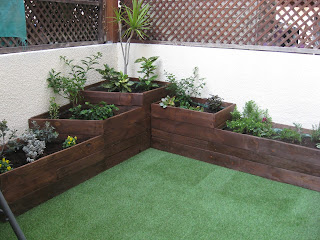I was alerted on Facebook, recently, that it was three years since we had converted our side yard into what, in the UK, we call a garden - although in the US it would still be called a yard, albeit with some plants.
Our friend Jacob and his colleague Mike did the hard work, and built these rather nice custom-designed planters. We then bought a few suitable-looking plants from various places.
Plants here are mostly not labelled in shops, and we don't know much about them anyway. So it was all a bit of guesswork Unsurprisingly, some of the plants didn't last more than a few months, and some died off during the following summer. But others grew.... and grew. So now it looks like this:
There's even an autumnal look with fallen leaves; I hope it doesn't mean that another plant is about to die. It's not as pretty as the original, but considerably more mature-looking, and easier to maintain. I have been watering them three times a week since the start of May, when the rain stopped, although it will be down to twice a week now, with slightly cooler temperatures arriving - and of course if it has rained within a few days, I won't water at all.
Here's another view of the current planters:





No comments:
Post a Comment